
Tuscola County is a county in the Thumb region of the U.S. state of Michigan. As of the 2020 census, the population was 53,323. The county seat is Caro. The county was created by Michigan Law on April 1, 1840, from land in Sanilac County and attached to Saginaw County for administrative purposes. The Michigan Legislature passed an act on March 2, 1850, that empowered the county residents to organize governmental functions.
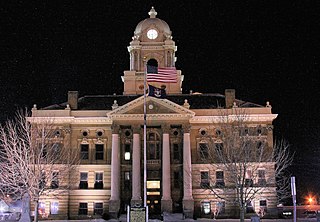
Shiawassee County is a county located in the U.S. state of Michigan. As of the 2020 United States Census, the population was 68,094. The county seat is Corunna, and the largest city in the county is Owosso. In 2010, the center of population of Michigan was located in Shiawassee County, in Bennington Township.

Genesee County is a county in the U.S. state of Michigan. As of the 2020 Census, the population was 406,211, making it the fifth-most populous county in Michigan. The county seat and population center is Flint. Genesee County consists of 33 cities, townships, and villages. It is considered to be a part of the greater Mid Michigan area.
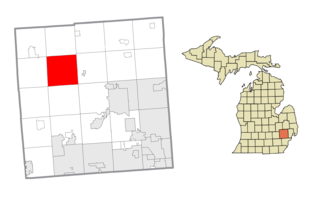
Springfield Charter Township is a charter township of Oakland County in the U.S. state of Michigan. As of the 2020 census, the township population was 14,703. The township was named for the numerous springs in the area.
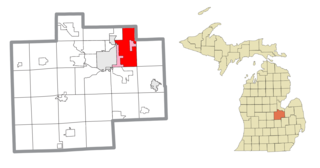
Buena Vista Charter Township is a charter township of Saginaw County in the U.S. state of Michigan. Per the 2020 census, the population was 7,664.

Chesaning is a village in Saginaw County in the U.S. state of Michigan. The population was 2,394 at the 2010 census. The village is located within Chesaning Township.
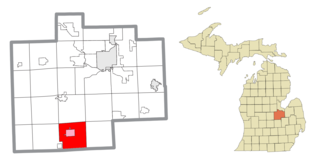
Chesaning Township is a civil township of Saginaw County in the U.S. state of Michigan. The population was 4,748 at the 2020 Census. The township was organized in 1847.

Frankenmuth is a city in Saginaw County in the U.S. state of Michigan. The population was 4,987 at the 2020 census. The city is surrounded by Frankenmuth Township.

Freeland is a census-designated place in Tittabawassee Township, Saginaw County in the U.S. state of Michigan. It is part of the Saginaw-Midland-Bay Metropolitan Area. As of the 2000 census, the CDP population was 5,147. The CDP covers an area in the central portion of Tittabawassee Township. The Freeland post office, ZIP code 48623, serves nearly the entire township, as well as portions of Midland and Williams townships to the north, Frankenlust and Kochville townships to the east, Thomas and Richland townships to the south, and Ingersoll Township to the west.

Saginaw is a city in and the seat of Saginaw County, Michigan, United States. It had a population of 44,202 at the 2020 census. Located along the Saginaw River, Saginaw is adjacent to Saginaw Charter Township and considered part of Greater Tri-Cities region of Central Michigan. The Saginaw metropolitan area had a population of 190,124 in 2020, while the Tri-Cities area had 377,474 residents.

The Thumb is a region and a peninsula of the U.S. state of Michigan, so named because the Lower Peninsula is shaped like a mitten. The Thumb area is generally considered to be in the Central Michigan region, east of the Flint area and the Tri-Cities and north of Metro Detroit. The region is also branded as the Blue Water Area.

Central Michigan, also called Mid Michigan, is a region in the Lower Peninsula of the U.S. state of Michigan. As its name implies, it is the middle area of the Lower Peninsula. Lower Michigan is said to resemble a mitten, and Mid Michigan corresponds roughly to the thumb and palm, stretching from Michigan's eastern shoreline along Lake Huron into the fertile rolling plains of the Michigan Basin. The region contains cities of moderate size, including Flint, Saginaw, and the state capital of Lansing. Generally Central, or "Mid", Michigan is defined by governmental organizations as an area North of Jackson, and South of Clare.
Michigan's 8th congressional district is a United States congressional district in Central Michigan. The district was first created in 1873, after redistricting following the 1870 census. From 2003 to 2013, it consisted of all of Clinton, Ingham, and Livingston counties, and included the southern portion of Shiawassee and the northern portion of Oakland counties. From 2013 to 2023, the district no longer covered Clinton or Shiawassee counties and instead covered more of Oakland County, including Rochester. In 2023, the district was redrawn to be centered on the city of Flint and the "Tri-Cities" metropolitan area around Saginaw, Midland, Bay City. The district includes all of Saginaw and Bay counties, almost all of Genesee County, and portions of Midland and Tuscola counties.

The School District of the City of Saginaw, known also as the Saginaw Public School District (SPSD) or Saginaw Public Schools, is a school district in Saginaw, Michigan. The district is a part of the Saginaw Intermediate School District, and serves the cities of Saginaw and Zilwaukee, the eastern part of Kochville Township, and portions of Buena Vista Township north of Hess Avenue.
Buena Vista School District was a school district headquartered in Buena Vista Charter Township, Michigan, and part of the Saginaw Intermediate School District. As of July 2013, the school district closed and became a tax-collecting district of the Saginaw ISD to pay the district's outstanding debts.

The Bridgeport-Spaulding Community School District is a school district headquartered in the Educational Services Center in Bridgeport, a community in Bridgeport Charter Township, Michigan.
Frankenmuth School District is a school district headquartered in Frankenmuth, Michigan. It is a part of the Saginaw Intermediate School District and serves the Frankenmuth area. Its schools include the Preschool, List Elementary School, E.F. Rittmueller Middle School, and Frankenmuth High School.
The Saginaw Intermediate School District (SISD) is an intermediate school district in Michigan, headquartered in Saginaw.
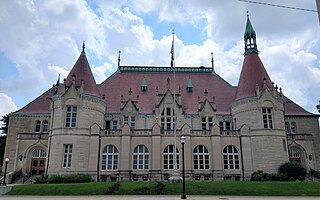
The Saginaw–Midland–Bay City Combined Statistical Area is a United States metropolitan area defined by the federal Office of Management and Budget (OMB) surrounding the Saginaw Bay and Saginaw River. The region is a part of the larger area known as Mid/Central Michigan. It includes the smaller statistical areas of Saginaw, Midland, and Bay City.






















